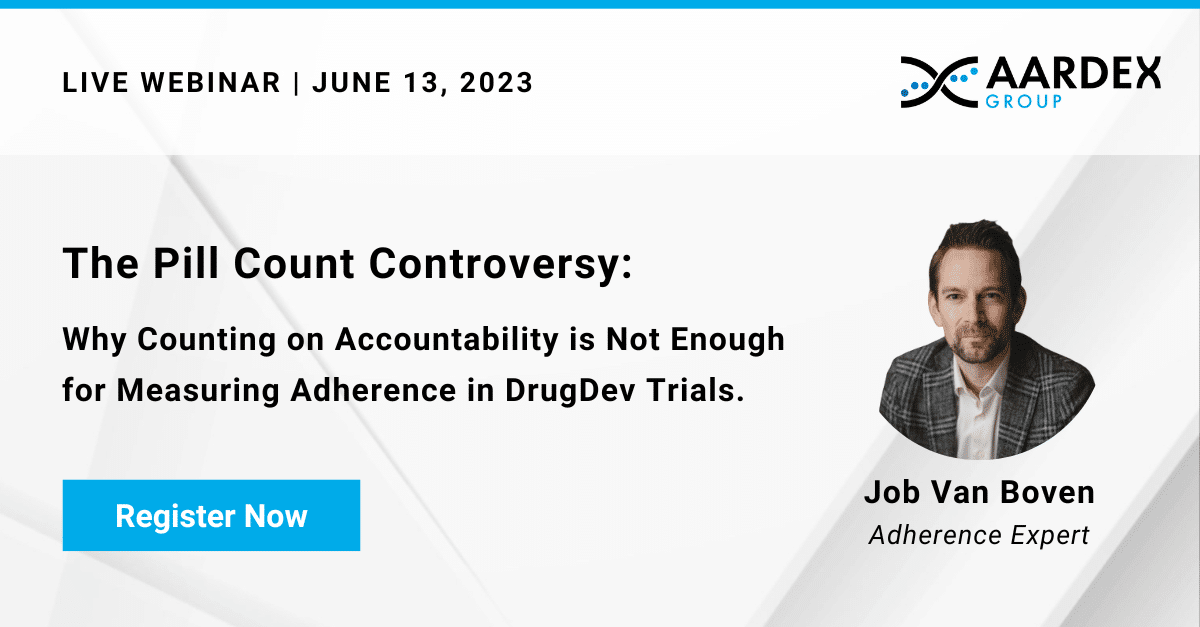In this article, our Scientific Lead and Adherence Expert, Bernard Vrijens, explores the use of pill count compliance in clinical trials and its reliability for measuring medication adherence.
Pressure is ubiquitous when it comes to conducting clinical trials. Sponsors feel the pressure to deliver the results they need to get their drug products to market. Investigators are under pressure to provide adherent participants. And, of course, there is pressure on participants to maintain a record of good medication adherence.
And therein lies one of the biggest conundrums for the entire clinical trial ecosystem – what measures can we implement to ensure optimal medication adherence and instill confidence that the drug will pass crucial safety and efficacy tests?
There is no disputing the fact that poor medication adherence is a significant problem in clinical trials. In fact, research shows that around 4% of participants do not even initiate taking the medicine, another 10-12% do not take their medication daily, and after one year, almost 40% of participants have stopped altogether[1].
The high levels of variability in compliance among participants, coupled with multiple subjective methods of measurement, have led to considerable discrepancies in trial results. These inconsistencies, ultimately, have the potential to affect participant outcomes. The impact isn’t just on the patient; however, such discrepancies can lead to a requirement to increase sample sizes and extend study timelines, which inevitably increase overall study costs.
Pill Count Compliance in Clinical Trials
According to a recent study[2], the most frequently applied method of monitoring remains pill count compliance, which was used singularly in 52.7% of assessed trials, and in combination with other methods in a further 37.7%.The Pill count compliance method involves researchers counting the number of pills dispensed and returned to determine the percentage of medication participants took in a clinical trial. For example, suppose a participant is prescribed a thirty-day supply of medication and is asked to return the unused pills at the end of the study. In this case, researchers will count how many pills were taken and how many remain. If twenty five pills are returned, researchers assume that the participant took five pills over the course of the study.
Is Pill Count Compliance a Reliable Method for Measuring Adherence?
In theory, the pill count compliance method could be a reliable method of measuring adherence – simply, if the pills aren’t returned, there is an assumption they have been taken. However, there are some huge challenges associated with this assumptive approach in practice. Indeed, several studies show that pill counting overestimates adherence to medication[3,4,5].
Often participants don’t want to ‘let down’ their healthcare professional. This is particularly true of participant clusters that consistently demonstrate poor adherence, and so they simply throw the excess pills away, creating a huge bias in the results, as much as 50% in some trials. Moreover, given that it’s exceptionally easy for patients to fake a perfect record of adherence, it happens way more than one would assume. In the US specifically, some patients join drug studies to have health insurance coverage.
In addition, regulators rely on the intention to treat (ITT) analysis. This is a method for analyzing results in a prospective randomized study where all participants who are randomized are included in the statistical analysis and analyzed according to the group they were originally assigned, regardless of what treatment (if any) they received. This essentially means researchers are analyzing data based on how the drug is prescribed and NOT as the drug is taken. To make sense of and confidently rely on such an approach requires a high level of adherence – without which the results are fundamentally flawed and irrelevant.
This situation heaps pressure on sponsors to find participants that are likely to perform/follow the prescribed dosing regimen for the ITT analysis to be relevant and robust. Understandably, this pressure is then passed on to investigators, who, if they are unable to deliver such adherence, will face the prospect of their ranking or reputation within the industry being diminished as well as being deselected for trials.
And there lies the start of the circle of uncertainty. Sponsors want and need investigators to deliver portfolios of adherent participants; however, the pill count compliance method for measuring adherence is fundamentally flawed.
The net effect is that the pressure is pushed down to the participant level to demonstrate good adherence by bringing back empty study packages (e.g., pill bottles). And so, the cycle of uncertainty is complete, resulting in doubts related to the drug safety and efficacy calculations.
Typically, Phase III trials report a 97.4% adherence rate (across 125 studies), yet definitions of adherence can be both variable and highly questionable. Why? Most of them assume an 80% threshold across 97% of participants, which equates to a 20% gap in adherence! What is perhaps more troublesome is that most trials will censor non-adherent participants by forcing them to drop out of the trial.
The bottom line, therefore, is that the pill count compliance method is a biased measure as it assumes a threshold and it censors non-adherent participants. As much down to culture as methodology, these nonsensical behaviors are evident in all studies but are most prevalent in regulatory drug trials simply because of the level of pressure incumbent on the sponsor, investigator, and participant.
Pill Count Compliance Alternatives
The good news is that there is a better way, one where the pressure valve is released, and the emphasis on promoting bad behavior is broken. MEMS AS® Medication Adherence Monitoring Software from AARDEX Group is a ground-breaking technology that harnesses the power of user-friendly medication adherence packaging and devices to gather medication adherence data passively, in real-time, and without the use of biased methodologies.
Indeed, recent academic research suggests that from the comparisons of measurement methods that were compatible and optimal, about 80% showed a significant difference between MEMS and non-electronic methods. Compared to MEMS, median adherence was overestimated by 17% using self-report, by 8% using pill count, and by 6% using patient-reported rating. Those differences suggest that non-electronic measures could lead to an overestimation of medication adherence(6).
The importance of delivering non-biased data at the end of clinical trials cannot be underestimated. Stakeholders are driven by a clear commercial need to get medicines to market successfully and safely, but that immense pressure is resulting in the current cycle of uncertainty that is translating into methods of adherence measurement that cannot be relied upon. Through innovative technology, the industry is afforded an opportunity to release the source of this pressure, enhance accuracy in adherence reporting and introduce a better way for the entire clinical trial ecosystem.
Register for our Upcoming Webinar to Learn More About Pill Count Compliance
Researching new therapies that have the potential to revolutionize modern medicine relies on patients taking their medications as prescribed – a requirement that’s crucial across all clinical trial phases. Despite the substantial body of evidence refuting the accuracy of pill count emerging, research indicates that this method, a method traditionally used to facilitate drug accountability, is still the primary method sponsors adopt to measure medication adherence.
Tune in from our next webinar with adherence experts, Job Van Boven, Associate Professor, University Medical Center Groningen, and Bernard Vrijens, Scientific lead, AARDEX Group, on June 13, 2023, at 10:00 AM EDT, to hear:
- Why it’s time to rethink the use of drug accountability methods to measure medication adherence in drug development, along with the supporting evidence.
- Practical advice on selecting objective and granular approaches that reduce site and patient burden.
References
- Blaschke TF, Osterberg L, Vrijens B, Urquhart J. Adherence to medications: in-sights arising from studies on the unreliable link between prescribed and actual drug dosing histories. Annu Rev Pharmacol Toxicol 2012;52:275–301. https://www.annualreviews.org/doi/10.1146/annurev-pharmtox-011711-113247
- KM Mantila, AM Pasmooij, PG Mol, C Erikstrup Hallgreen, JF van Boven. Medication Adherence in Registration Trials. Supporting the Approval of New Medicines in the European Union 2010-2020. Clinical Pharmacology & Therapeutics 2022; 112(5):1051-1060
- Cramer JA, Mattson RH, Prevey ML, Scheyer RD, Ouellette VL: How often is medication taken as prescribed? A novel assessment technique. JAMA 1989;261:3273–3277.
- Pullar T, Kumar S, Tindall H, Feely M: Time to stop counting the tablets? Clin Pharmacol Ther 1989;47:547.
- Matsui D, Hermann C, Klein J, Berkovitch M, Olivieri N, Koren G: Critical comparison of novel and existing methods of compliance assessment during a clinical trial of an oral iron chelator. J Clin Pharmacol 1994;34:944–949.
- A scoping review of studies comparing the medication event monitoring system (MEMS)with alternative methods for measuring medication adherence. Mohamed El Alili, Bernard Vrijens, Jenny Demonceau, Silvia M. Evers, and Mickael Hiligsmann.




